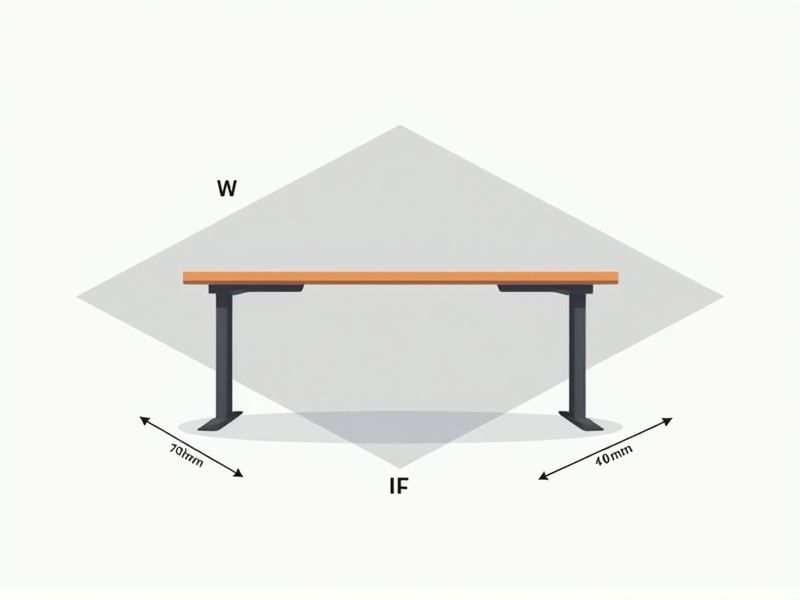
When selecting a computer table, it's useful to know the standard dimensions to ensure a comfortable and ergonomic setup. Typically, a standard computer table measures around 48 inches (122 cm) in width, 24 to 30 inches (61-76 cm) in depth, and about 28 to 30 inches (71-76 cm) in height. These dimensions provide enough space for a monitor, keyboard, and other accessories while allowing for comfortable legroom. Always consider your available space and needs before making a final choice, as adjustable or custom options can better fit unique requirements.
Ergonomic Height
An ergonomic computer table typically features an adjustable height range of 28 to 48 inches, accommodating various user preferences and promoting proper posture. The surface area often measures around 47 to 63 inches in width, providing ample space for dual monitors and ergonomic accessories. By allowing a sit-stand option, these tables can significantly reduce the risk of health issues related to prolonged sitting, with studies indicating a potential increase in productivity by up to 15%. Prioritizing ergonomics in your workspace can lead to better comfort, reduced strain, and enhanced focus during long hours of computer use.
Width For Monitor
When selecting a computer table, ensuring the width accommodates your monitor is crucial for ergonomic comfort and workspace efficiency. For an optimal setup, tables should have a minimum width of 47 inches (120 cm) to comfortably house a single monitor, while dual-monitor configurations typically require at least 60-70 inches (152-178 cm) of width. This allows for adequate distance from the eye to the screen, which should be around 20-30 inches (50-76 cm) to reduce eye strain. Furthermore, consider the depth of the table, ensuring it provides enough space for your keyboard, mouse, and any additional accessories you may need.
Depth For Keyboard
When selecting a computer table, the depth is crucial for ergonomic comfort, particularly for keyboard placement. Ideally, a depth of 24 to 30 inches (61 to 76 centimeters) provides ample space for a keyboard and mouse, allowing you to maintain a natural wrist position. This depth also facilitates an organized workspace, ensuring your monitor is at an appropriate distance while keeping your hands within easy reach of your input devices. Your overall productivity can improve significantly with the right table design that accommodates your ergonomic needs.
Legroom Clearance
When selecting a computer table, prioritize a legroom clearance of at least 24 inches to ensure comfort during long hours of use. An adequate height, typically between 28 to 30 inches, allows most users to maintain an ergonomic posture while typing or working. Consider tables with adjustable heights, allowing flexibility for various user preferences and ensuring optimal legroom. Investing in a design that accommodates these measurements can significantly improve your productivity and reduce fatigue.
Space For Accessories
When selecting a computer table, prioritize models that offer ample space for accessories to enhance your workspace efficiency. Look for designs with dedicated storage solutions, such as drawers and shelves, to keep items like chargers, notebooks, and office supplies organized and easily accessible. A table with a surface area of at least 60 inches in width provides sufficient room for dual monitors and other equipment, improving your productivity. Consider options with cable management systems to minimize clutter and create a clean, professional appearance in your setup.
Cable Management Slots
A computer table with efficient cable management slots significantly enhances your workspace by minimizing clutter. Typically, these tables feature strategically placed grommets or trays designed to organize and conceal various cables, keeping them out of sight and reducing tangles. Most models offer dimensions of around 47 to 63 inches in width, accommodating multiple monitors and devices while maintaining an orderly appearance. By investing in a computer table with optimized cable management, you create a streamlined environment that boosts productivity and aesthetics.
Adjustable Components
An adjustable computer table typically features height-adjustable legs, allowing users to customize their workspace according to individual preference, often ranging from 28 to 48 inches high. The surface area usually spans between 48 to 72 inches in width, providing ample space for monitors, laptops, and accessories. Many models incorporate cable management systems, helping to keep cords organized and out of sight, enhancing your desk's aesthetics. Ergonomic designs are paramount, with recommendations often suggesting that screens are positioned at eye level to reduce neck strain during prolonged use.
Mouse Space
A standard computer table typically provides a mouse space of at least 12 inches by 10 inches, ensuring comfortable movement for optimal performance. The surface area should range from 48 inches to 72 inches in width, accommodating not only your monitor but also essential peripherals like your keyboard and mouse. To enhance ergonomics, the table height should be adjustable between 28 to 32 inches, allowing you to maintain a neutral wrist position while using your mouse. Investing in a table that prioritizes adequate mouse space can significantly improve your overall productivity and comfort during extended computer sessions.
Monitor Viewing Distance
The optimal viewing distance for a monitor on a computer table typically ranges between 20 to 40 inches (50 to 100 cm) from your eyes, ensuring comfort and reducing eye strain. Adjusting your monitor to be at eye level helps maintain a proper posture, ideally at a height where your eyes are aligned with the top third of the screen. For a 24-inch monitor, a distance of approximately 24 inches (60 cm) is recommended for the best clarity and detail. Maintaining this standard not only enhances your productivity but also promotes a healthier workspace environment.
Drawer Or Storage Space
A standard computer table typically features multiple drawers or storage spaces, which enhance organization and accessibility. Most models offer at least one dedicated drawer for storing essential items such as stationery or documents. Storage spaces can include shelves or compartments designed specifically for your computer peripherals, like printers or scanners. Depending on the design, the available storage can range from 15 to 30 inches in width, accommodating various personal and professional needs.
